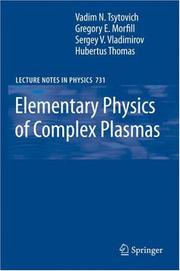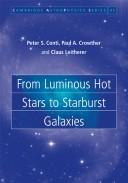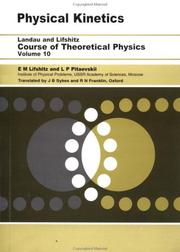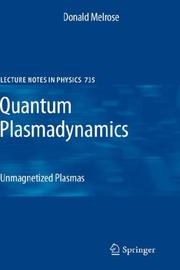| Listing 1 - 8 of 8 |
Sort by
|
Book
ISBN: 9782862724775 Year: 2008 Volume: 12 Publisher: Saint-Etienne : Publications de l'Université de Saint-Etienne,
Abstract | Keywords | Export | Availability | Bookmark
 Loading...
Loading...Choose an application
- Reference Manager
- EndNote
- RefWorks (Direct export to RefWorks)
Propose une histoire des plasmas froids du XVIIIe siècle à aujourd'hui, un point sur l'art des plasmas thermiques et une présentation des nouvelles sources de plasmas.
Low temperature plasmas --- Low temperature plasmas --- Plasmas froids --- Plasmas froids --- History --- Histoire
Book
ISBN: 9783540749523 3540749527 3540749543 Year: 2008 Publisher: Berlin Springer
Abstract | Keywords | Export | Availability | Bookmark
 Loading...
Loading...Choose an application
- Reference Manager
- EndNote
- RefWorks (Direct export to RefWorks)
Particles (Nuclear physics) --- Physics --- Plasma (Ionized gases) --- Spectrum analysis --- Atoms, Molecules, Clusters and Plasmas --- Characterization and Evaluation of Materials --- Laser Technology and Physics, Photonics --- Optical Spectroscopy, Ultrafast Optics --- Solid State Physics and Spectroscopy --- Laser spectroscopy. --- Laser spectroscopy
Book
ISBN: 3540769552 3642095631 9786611955168 1281955167 3540769579 Year: 2008 Publisher: Berlin : Springer,
Abstract | Keywords | Export | Availability | Bookmark
 Loading...
Loading...Choose an application
- Reference Manager
- EndNote
- RefWorks (Direct export to RefWorks)
Black hole gravitohydromagnetics (GHM) is developed from the rudiments to the frontiers of research in this book. GHM describes plasma interactions that combine the effects of gravity and a strong magnetic field, in the vicinity (ergosphere) of a rapidly rotating black hole. This topic was created in response to the astrophysical quest to understand the central engines of radio loud extragalactic radio sources. The theory describes a "torsional tug of war" between rotating ergospheric plasma and the distant asymptotic plasma that extracts the rotational inertia of the black hole. The recoil from the struggle between electromagnetic and gravitational forces near the event horizon is manifested as a powerful pair of magnetized particle beams (jets) that are ejected at nearly the speed of light. These bipolar jets feed large-scale magnetized plasmoids on scales as large as millions of light years (the radio lobes of extragalactic radio sources). This interaction can initiate jets that transport energy fluxes exceeding 1047 ergs/s. This second edition of the book is updated throughout and contains a completely new chapter discussing state of the art and results of numerical simulations of ergospheric disk jets occuring in magnetohydrodynamic accretion flows.
Black holes (Astronomy). --- Magnetohydrodynamics. --- Plasma astrophysics. --- Astronomy & Astrophysics --- Physical Sciences & Mathematics --- Astrophysics --- Black holes (Astronomy) --- Magneto-hydrodynamics --- MHD (Physics) --- Planetology. --- Astrophysics and Astroparticles. --- Classical and Quantum Gravitation, Relativity Theory. --- Fluid dynamics --- Plasma dynamics --- Astrophysical plasmas --- Plasmas, Astrophysical --- Plasma (Ionized gases) --- Frozen stars --- Compact objects (Astronomy) --- Gravitational collapse --- Stars --- Planetary sciences --- Planetology --- Astrophysics. --- Gravitation. --- Field theory (Physics) --- Matter --- Physics --- Antigravity --- Centrifugal force --- Relativity (Physics) --- Astronomical physics --- Astronomy --- Cosmic physics --- Properties

ISBN: 3642067034 3540290036 3540290001 9783540290001 Year: 2008 Publisher: Berlin Springer
Abstract | Keywords | Export | Availability | Bookmark
 Loading...
Loading...Choose an application
- Reference Manager
- EndNote
- RefWorks (Direct export to RefWorks)
Complex plasmas are dusty plasmas in which the density and electric charges of the dust grains are sufficiently high to induce long-range grain-grain interactions, as well as strong absorption of charged-plasma components. Together with the sources replenishing the plasma such systems form a highly dissipative thermodynamically open system that exhibits many features of collective behaviour generally found in complex systems. Most notably among them are self-organized patterns such as plasma crystals, plasma clusters, dust stars and further spectacular new structures. Beyond their intrinsic scientific interest, the study of complex plasmas grows in importance in a great variety of fields, ranging from space-plasma sciences to applied fields such as plasma processing, thin-film deposition and even the production of computer chips by plasma etching, in which strongly interacting clouds of complex plasmas can cause major contamination of the final product. Intended as first introductory but comprehensive survey of this rapidly emerging field, the present book addresses postgraduate students as well as specialist and nonspecialist researchers with a general background in either plasma physics, space sciences or the physics of complex systems.
Dusty plasmas. --- Plasma (Ionized gases) --- Gaseous discharge --- Gaseous plasma --- Magnetoplasma --- Ionized gases --- Dust plasma systems --- Plasmas, Dusty --- Dust --- Dusty plasmas --- Nuclear physics. --- Astrophysics. --- Atoms and Molecules in Strong Fields, Laser Matter Interaction. --- Nuclear Physics, Heavy Ions, Hadrons. --- Plasma Physics. --- Space Sciences (including Extraterrestrial Physics, Space Exploration and Astronautics). --- Complex Systems. --- Soft and Granular Matter, Complex Fluids and Microfluidics. --- Astronomical physics --- Astronomy --- Cosmic physics --- Physics --- Atomic nuclei --- Atoms, Nuclei of --- Nucleus of the atom --- Atoms. --- Physics. --- Heavy ions. --- Plasma (Ionized gases). --- Space sciences. --- Statistical physics. --- Dynamical systems. --- Amorphous substances. --- Complex fluids. --- Complex liquids --- Fluids, Complex --- Amorphous substances --- Liquids --- Soft condensed matter --- Dynamical systems --- Kinetics --- Mathematics --- Mechanics, Analytic --- Force and energy --- Mechanics --- Statics --- Mathematical statistics --- Science and space --- Space research --- Cosmology --- Science --- Ions --- Natural philosophy --- Philosophy, Natural --- Physical sciences --- Dynamics --- Chemistry, Physical and theoretical --- Matter --- Stereochemistry --- Statistical methods --- Constitution

ISBN: 9780521791342 0521791340 9780511536199 9781107407732 9780511457494 0511457499 0511456182 9780511456183 9780511454455 0511454457 9780511455483 0511455488 1107194814 1281944815 9786611944810 0511453477 0511536194 Year: 2008 Publisher: Cambridge Cambridge University Press
Abstract | Keywords | Export | Availability | Bookmark
 Loading...
Loading...Choose an application
- Reference Manager
- EndNote
- RefWorks (Direct export to RefWorks)
Luminous hot stars represent the extreme upper mass end of normal stellar evolution. Before exploding as supernovae, they live out their lives of a few million years with prodigious outputs of radiation and stellar winds, dramatically affecting both their evolution and environments. A detailed introduction to the topic, this book connects the astrophysics of massive stars with the extremes of galaxy evolution represented by starburst phenomena. A thorough discussion of the physical and wind parameters of massive stars is presented. HII galaxies, their connection to starburst galaxies, and the contribution of starburst phenomena to galaxy evolution through superwinds, are explored. The book concludes with the wider cosmological implications, including Population III stars, Lyman break galaxies and gamma-ray bursts, for each of which massive stars are believed to play a crucial role. This book is ideal for graduate students and researchers in astrophysics interested in luminous hot stars and galaxy evolution.
Starbursts --- Gamma ray bursts --- Stars --- Stellar winds --- Etoiles --- Vents stellaires --- Evolution --- Starbursts. --- Gamma ray bursts. --- Stellar winds. --- Winds, Stellar --- Space plasmas --- Stellar activity --- Stellar evolution --- Compact objects (Astronomy) --- Bursts, Cosmic gamma ray --- Bursts, Gamma ray --- Cosmic gamma ray bursts --- Transients, Gamma ray --- Gamma ray astronomy --- X-ray bursts --- Star bursts --- Starburst galaxies --- Evolution. --- Winds

ISBN: 0750626356 9780750636354 9786613611680 0080570496 1280581905 9780080570495 9780750626354 9781280581908 6613611689 Year: 2008 Publisher: Amsterdam Boston
Abstract | Keywords | Export | Availability | Bookmark
 Loading...
Loading...Choose an application
- Reference Manager
- EndNote
- RefWorks (Direct export to RefWorks)
This volume is mainly concerned with a systematic development of the theory of plasmas, the authority being firmly rooted in the pioneering work of Landau. Corresponding results are also given for partially ionized plasmas, relativistic plasmas, degenerate or non-ideal plasmas and solid state plasmas.
530.1 --- 530.1 Basic principles of physics --- Basic principles of physics --- Kinetic theory of gases --- Plasma (Ionized gases) --- Solid state physics --- Mathematical physics --- Physique mathématique --- Kinetic theory of matter. --- Physique de l'état solide. --- Gaz, Théorie cinétique des. --- Plasmas (gaz ionisés) --- Matière, Théorie cinétique de la. --- Study and teaching (Higher) --- Etude et enseignement (supérieur) --- Gaseous discharge --- Gaseous plasma --- Magnetoplasma --- Ionized gases --- Étude et enseignement (supérieur)

ISBN: 9780387739021 0387739025 0387739033 Year: 2008 Publisher: New York, New York : Springer,
Abstract | Keywords | Export | Availability | Bookmark
 Loading...
Loading...Choose an application
- Reference Manager
- EndNote
- RefWorks (Direct export to RefWorks)
The field of quantum plasmas has a long and diverse tradition and is becoming of increasing current interest, motivated by applications to micro-electronics and to focused high-power lasers. In this book, plasma kinetic theory is developed in a covariant (4-tensor) notation, which facilitates generalizations to include all relativistic and electromagnetic effects. Relativistic quantum effects are included by using quantum electrodynamics (QED) to calculate the plasma response 4-tenors. The effects of the plasma are included in QED by replacing the photon propagator in vacuo by that in the medium, such that the poles of this propagator correspond to the natural wave modes of the medium.
Plasma dynamics. --- Quantum electrodynamics. --- Plasmas, Dynamique des --- Electrodynamique quantique --- Plasma dynamics --- Quantum electrodynamics --- Electricity & Magnetism --- Astrophysics --- Astronomy & Astrophysics --- Physics --- Physical Sciences & Mathematics --- Electrodynamics, Quantum --- QED (Physics) --- Snowplow effect --- Physics. --- Quantum physics. --- Astrophysics. --- Atoms. --- Matter. --- Plasma (Ionized gases). --- Astrophysics and Astroparticles. --- Quantum Physics. --- Atoms and Molecules in Strong Fields, Laser Matter Interaction. --- Plasma Physics. --- Quantum field theory --- Schwinger action principle --- Dynamics --- Plasma (Ionized gases) --- Magnetohydrodynamics --- Quantum theory. --- Quantum dynamics --- Quantum mechanics --- Quantum physics --- Mechanics --- Thermodynamics --- Astronomical physics --- Astronomy --- Cosmic physics --- Gaseous discharge --- Gaseous plasma --- Magnetoplasma --- Ionized gases --- Natural philosophy --- Philosophy, Natural --- Physical sciences --- Chemistry, Physical and theoretical --- Matter --- Stereochemistry --- Constitution
Book
ISBN: 9780387791081 0387791078 9780387791074 1441927115 9786612287671 1282287672 0387791086 Year: 2008 Publisher: New York : Springer,
Abstract | Keywords | Export | Availability | Bookmark
 Loading...
Loading...Choose an application
- Reference Manager
- EndNote
- RefWorks (Direct export to RefWorks)
Cathodic Arcs: From Fractal Spots to Energetic Condensation is the first book in over a decade dedicated to the physics and technology of cathodic arcs. It includes a detailed account of arc history, a textbook-like introduction to cathode phenomena, and some basic physics of expanding plasmas; it deals with the infamous macroparticle issue and describes a host of practical plasma filter solutions. In contrast to previous books on cathodic arcs, the focus is on the relation of arc plasmas and their properties to surface modification and thin film deposition. The book contains sections on basic plasma physics and thin film materials science. It also deals with practical issues of coatings such as stress control and the often-underrated issue of the coating’s color. By stressing the fractal nature of cathode spots, the theme of fluctuations can be found throughout the book: fluctuations affect all plasma properties and thereby have consequences for plasma-based surface modifications and film growth. Detailed explanations are complemented by compilations of plasma and materials data arranged in Periodic Tables. Cathodic Arcs: From Fractal Spots to Energetic Condensation is written with researchers and advanced students in the fields of materials science and plasma physics in mind. It is suitable both as a reference work for the expert as well as an introduction for newcomers to the interdisciplinary fields of plasma-surface interaction and plasma-assisted deposition of thin films. .
Physics. --- Atoms, Molecules, Clusters and Plasmas. --- Industrial Chemistry/Chemical Engineering. --- Surfaces and Interfaces, Thin Films. --- Condensed Matter. --- Chemical engineering. --- Plasma (Ionized gases). --- Condensed matter. --- Surfaces (Physics). --- Physique --- Génie chimique --- Plasma (Gaz ionisés) --- Matière condensée --- Surfaces (Physique) --- Cathode rays. --- Intermittency (Nuclear physics). --- Cathode rays --- Intermittency (Nuclear physics) --- Plasma (Ionized gases) --- Physics --- Physical Sciences & Mathematics --- Atomic Physics --- Electricity & Magnetism --- Gaseous discharge --- Gaseous plasma --- Magnetoplasma --- Fractal structure (Nuclear physics) --- Atoms. --- Materials --- Thin films. --- Atomic, Molecular, Optical and Plasma Physics. --- Condensed Matter Physics. --- Surfaces. --- Cathodes --- Electric discharges through gases --- Electrons --- Radiation --- Radioactivity --- X-rays --- Ionized gases --- Nuclear physics --- Surface chemistry --- Surfaces (Technology) --- Chemistry, Industrial --- Engineering, Chemical --- Industrial chemistry --- Engineering --- Chemistry, Technical --- Metallurgy --- Materials—Surfaces. --- Condensed materials --- Condensed media --- Condensed phase --- Materials, Condensed --- Media, Condensed --- Phase, Condensed --- Liquids --- Matter --- Solids --- Films, Thin --- Solid film --- Solid state electronics --- Coatings --- Thick films --- Natural philosophy --- Philosophy, Natural --- Physical sciences --- Dynamics --- Chemistry, Physical and theoretical --- Stereochemistry --- Constitution --- Surface phenomena --- Friction --- Surfaces (Physics) --- Tribology --- Surfaces
| Listing 1 - 8 of 8 |
Sort by
|

 Search
Search Feedback
Feedback About UniCat
About UniCat  Help
Help News
News